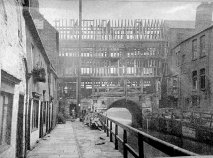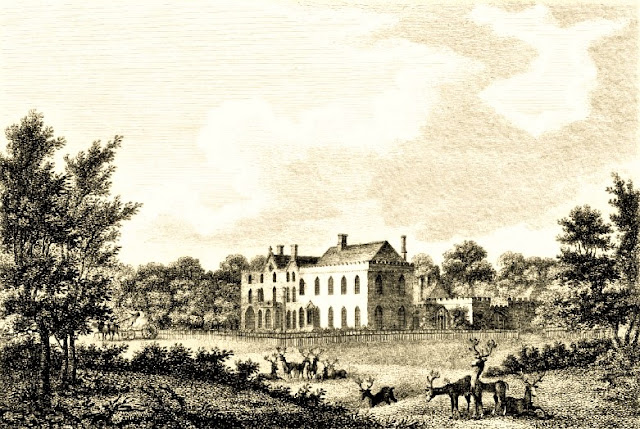
 |
| The Glory Hole, showing medieval ribbing |
 |
| 1902/3 Reconstruction |
A blog about the history of Lincolnshire; people, places, companies.

 |
| The Glory Hole, showing medieval ribbing |
 |
| 1902/3 Reconstruction |
 |
| The Priory, south and east aspects c. 1800 |

 |
| South aspect c 1925 |
 |
| East end of south aspect and Orangery |

 |
Remains of St Andrew's Church, Calceby |
 |
| Aerial Map of Calceby, showing outlines of various features (Bing) |
 |
| Sudbrook Holm c. 1800 |
 |
| Sudbrook Park early 20th century |

The preceptory of Templum de la Bruere, or Temple on the Heath, otherwise known as Temple Bruer was founded in the 12th Century by Lady Elizabeth de Calz on land donated by William of Ashby. William was soon afterwards admitted into the fraternity of the house, he later increased the original endowment. Among the other benefactors are John d'Eyncourt, Robert of Everingham, William de Vescy and Gilbert of Ghent. The house appears to have been of considerable size and importance being the administration centre for many of the Templar houses in the area.
In 1306 permission was granted to crenellate the great gate. By 1308 it was the second richest Templar house in England.
The story of the suppression of the Templars is well-known, a plot devised by King Philip IV of France with the help of Pope Clement V; Philip owed a considerable financial debt to the Templars.
The suppression of the Temple Bruer preceptory was carried out on 10th January 1308 by the Sheriff of Lincolnshire, John de Cormel, following orders from Edward II. William de la More - the last Preceptor of Temple Bruer, and Grand Prior of all England, together with his knights were imprisoned, with those of other Templar houses in the district, in Claxlede Gate and other places in Lincoln. The Templars were held until their trial began on 25th November 1309, the Knights were arraigned in the Chapter House of the Cathedral and tried on the following charges :
To all these charges they pleaded not guilty, and said that “if their brethren in France had confessed such things they lied, to screen themselves from the torture of the rack.”
Most of the charges were without any foundation, it was their immense wealth that the king wanted.
Fuller, a historian, wrote, “their wealth was the principal cause of their overthrow. We may believe that King Philip would never have took away their lives, if he might have took their lands without putting them to death; but the mischief was, he could not get the honey, unless he burnt the bees.”
Following the suppression of the Templars, the Knights Hospitallers took over the Preceptory and in 1338 a commandery of the Hospitallers Order under the same preceptor who commanded the house at Eagle.
In 1338 the revenue of the house was £177 7s. 7d., including the churches of Ashby and Rowston, the free chapel of Bruer, with lands at Bruer, Rowston, Wellingore, Ashby, Brauncewell, and North Kirkby; the expenses were £84 0s. 2d. The clear value of the house at the dissolution was £16 19s. 10¾d., including the bailiwick of South Witham and the farm of half the rectory and the grange of Holme in Heckington, with perquisites of a court
During the 15th century the de Launde family, descendants of William of Ashby, made several attempts to recover the church of Ashby from the Hospitallers, the situation was still unresolved in 1531.
In 1539 Sir Giles Russell was made commander of Temple Bruer, but finding that the house was in a ruinous condition he did not live there and made some effort to get it repaired and put in a better condition. In 1539 he was in Malta, he probably saw little of his commandery before its dissolution in 1541.
The fifteenth-century seal of the preceptor of Temple Bruer is a pointed oval representing a castle elaborately designed, with an outer wall of masonry embattled, circular keep embattled, and on it an Agnus Dei.
 |
| Tower and Medieval House |
Henry VIII with his queen, Catherine Howard, commenced a grand tour of England in 1541, to hold a conference with his nephew, the King of Scotland and secondly to visit Lincolnshire and Yorkshire to observe that the counties were at peace after the disruptions caused by the "Pilgrimage of Grace". The king had a meeting and Sleaford on the 9th of August and dined the same day at Temple Bruer on his way to Lincoln.
 |
| The Tower c.1800 |
 |
| The light tint shows the vaults and passages beneath the church |
The next archaeological excavation was in 1907, under the supervision of Sir William Henry St John Hope. Hope found two sets of stairs leading to the crypt, but he didn't find the cellars or passages referred by Oliver, but there is a suspicion that the purpose of the excavation was to disprove Olivers' findings. Hope did plot more of the site, enabling more accurate artists impressions of the site.
| Post updated Go to https://itsaboutlincoln.blogspot.com/2020/02/cold-bath-house-parish-was-created-in.html  |
| Cottam's Mill by W N Tollerton (Lincoln Central Library Collection) |
 |
| Newland, the location of the Butter Cross |
 |
| The 1847 Corn Exchange |